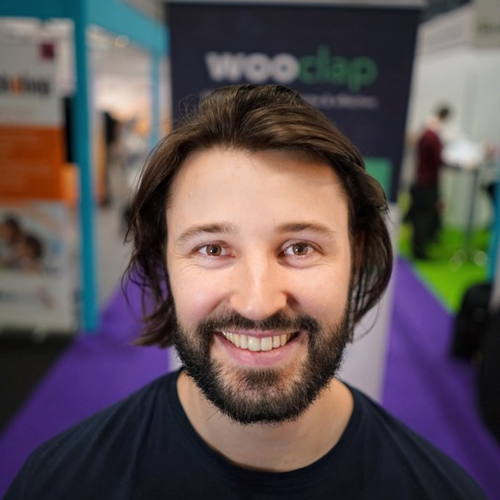Getting smarter through technology and big data
09.02.2021 • 6 minutes

In late January, we hosted a woobinar to discuss the role of Education Technology in British and Irish higher education. Among our esteemed speakers was Professor Nick Petford, Vice Chancellor at Northampton University, who talked about his institution’s “future-focused” digital strategy.
Embracing the potential of EdTech has allowed Northampton University to implement their Active Blended Learning (ABL) pedagogy, leverage virtual and augmented reality in their courses, and use big data to guide holistic decision-making within their strategy.
Due to time constraints, Professor Petford was unable to answer all the questions we received during the woobinar. Luckily, he was keen to provide written answers afterwards, and here they are:
How have your own students’ results changed since implementing active blended learning?
Professor Nick Petford (P.N.P.): This will be reported in detail in a forthcoming Tech Trends article along with student comments.
In brief:
- A quality learning experience is necessary but not sufficient for a quality overall student experience.
- The role of tutors is central to both. To promote student engagement with learning and a sense of belonging, students see the building of partnerships with their tutors as critical.
- Students expect productive experiences that permeate different learning settings, of which the classroom is one.
- Students value regular synchronous and asynchronous interaction with peers, tutors and content, usually enabled by sound pedagogic design and the appropriate deployment of digital technologies.
- Students expect activities that promote meaningful interactions before, during and after sessions.
- Employability-focused activities that explicitly link theory and practice are regarded as integral.
- Students view support as a holistic, all-encompassing term that integrates academic and pastoral aspects.
What would you say is the biggest challenge of active blended learning?
P.N.P.: Implementing a new pedagogical approach for a whole institution involves a number of real benefits along with inevitable challenges of the change management processes. The staff experience will be reported in detail shortly in a publication in the journal “Teaching in Higher Education”. The student experience was previously reported based on internal research.
This went hand in hand with physical and IT changes for Waterside that made the implementation much easier than if we’d stayed at the old campuses with its pre-ABL infrastructure. Breaking that down a bit more it was shifting mindsets away from replicating practice to doing something new, something that the new ways of working / of learning and teaching enabled that wasn’t previously possible. So we wanted to move from substitution (using tech appropriately for pedagogic purposes and not just for the sake of it) to enhancement, to creativity, to the ‘new’. And alongside that having a healthy appetite for risk, sharing lessons – including what didn’t work.
How did you approach the development of staff understanding of this ‘new’ pedagogy? Active learning is so important for sense making. How is this facilitated online?
P.N.P.: This will be reported in detail shortly in a publication in the journal “Teaching in Higher Education”. There was a multi facilitated approach to develop staff understanding through regular communication, support and changes to curriculum development processes. Online facilitation needs to be developed from the ground up and not just converted from existing face to face sessions – it is not a case of substitution. It has to be intentionally designed. Things don’t work the same online as they do F2F and they do take longer.
The University invested heavily in the Learning Design team in implementing ABL. It introduced a curriculum re/design model internally termed CAIeRO (Creating Aligned and Interactive educational Resource Opportunities) to assist staff with the move. The University focus was on upskilling staff, not on doing it for them. So we worked alongside staff who were the ‘content’ owners. We also found ways to open up the dialogue with staff – recognising the good practice in what they already did and allowing them to also ‘make sense’ of what was going on – the ‘do more of what you value’ approach.
A staff development process was put in place termed C@N-DO (Changemaker at Northampton Development Opportunities). This is about staff agency over the development process. Fellowship is the start for a PGCAP, not something you do as part of a PGCAP – an important difference. Staff pick and choose what they need in order to enhance their own practice. It is not mandated for them. This allows them to tailor their CPD based on their needs and recognises that each person has different development requirements.
Active learning online (to answer the second question) has been more challenging. One of the Acting tutors would be a good example of being solution focused through the development of the Shakespeare in lockdown films. She also has a brilliant expectations document which helped students with preparation of learning online. Some staff have been concerned about the risk of reverting to lecture type delivery. To support this, there have been changes to the lecture capture policy to address the need for their use to be pedagogically determined, accessibility, pedagogic value of shorter, and based on focused recordings. The University has also had to enhance use of webinar software (Kaltura and Collaborate) that supports breakout rooms.
How would you integrate things like VR into arts subjects? Do you plan to?
P.N.P.: We already have started work on these areas.
There has also been interaction between Arts and Science such as the AR sculpture walk around campus. The University has also worked with digital and tech experts in business, education, healthcare and more from Northamptonshire and beyond on Merged Futures. This is Digital Northampton’s annual technology innovation showcase (now in its third year).
What results have surprised you from your smart campus? How has it made you change/adapt?
P.N.P.: Whilst COVID has impacted on the current use, we continue to maximise the benefits of the smart campus through enhanced network analytics and improved space management. One of the core principles of the campus is adaptability so we use the ‘smartness’ to make changes quickly and effectively matching student and staff needs – catering spaces have changed, teaching spaces repurposed and staff workspaces evolved. This is data driven including feedback from staff and student surveys alongside analytics. We have also reduced our carbon footprint by 40% and are on track for net zero carbon by 2030.
Many thanks to Professor Petford for providing these insights, and to the woobinar’s participants for asking such interesting questions. If you haven’t yet had the chance to watch the entire thing, check it out below!
Writer

Gauthier Lebbe
Content Editor @Wooclap. I love to write, learn, write about learning, and learn about writing. And hit readers with puns they don't see coming. You know, sucker puns.
Subject
A monthly summary of our product updates and our latest published content, directly in your inbox.


